The Ford F150, America’s beloved pickup truck, is known for its durability and versatility. However, even the most rigid trucks need regular maintenance, especially interior cleanliness. While comfortable and cost-effective, cloth seats can be magnets for dirt, stains, and odors.
This comprehensive guide will walk you through 15 proven DIY methods to keep your Ford F150‘s cloth seats looking and smelling fresh.
Why Clean Your F150’s Cloth Seats?
Before getting into the methods, it’s important to understand why regular cleaning is crucial:
- Maintain resale value: A clean interior can significantly impact your truck’s value.
- Prevent wear and tear: Regular cleaning prevents dirt and grime from breaking down fabric fibers.
- Improve air quality: Clean seats mean fewer allergens and better air quality inside your truck.
- Enhance comfort: Clean seats are more pleasant to sit on during long drives.
DIY Methods to Clean Ford F150 Cloth Seats
1. Paper Towel Wipe-Down
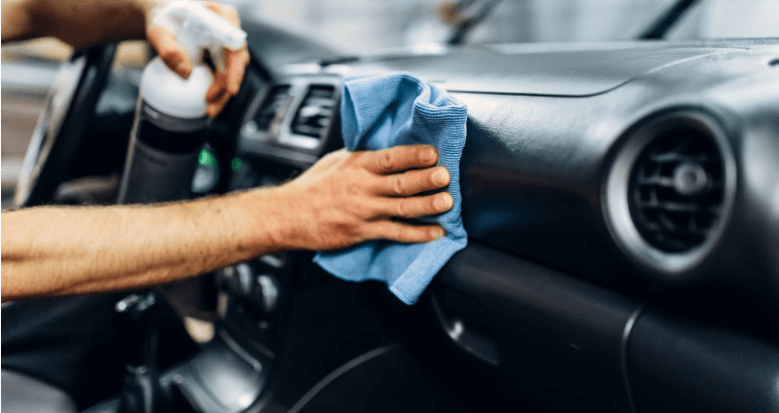
The simplest starting point using microfiber cloths and water for regular dust and light dirt removal.
What you’ll need: Microfiber cloth or paper towels, water
- Start with a dry microfiber cloth to remove loose dust and debris.
- Dampen the cloth with water and gently wipe the seats.
- Pay extra attention to corners and seams where dirt accumulates.
- Use a dry section of the cloth to absorb excess moisture.
Pro tip: For stubborn dirt, use a soft-bristled brush before wiping.
2. Vacuum Cleaning
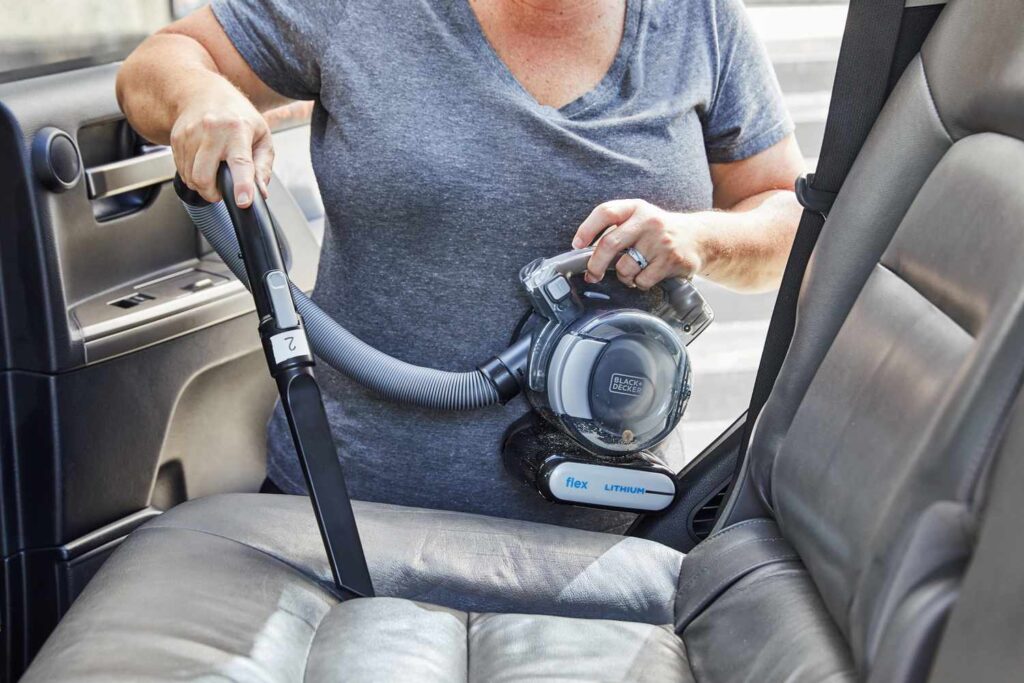
Your go-to method for removing loose debris, crumbs, and surface dirt using proper upholstery attachments
What you’ll need: Vacuum cleaner with upholstery attachment
- Remove any large debris by hand.
- Use the upholstery attachment to vacuum the entire seat surface.
- Pay special attention to seams, crevices, and between the seat and backrest.
- Use the crevice tool for hard-to-reach areas.
Pro tip: Vacuum regularly to prevent dirt buildup.
3. Removing Ink Stains
Targeted approach using rubbing alcohol and cotton swabs to tackle pen marks and ink blots.
What you’ll need: Rubbing alcohol, cotton swabs
- Dip a cotton swab in rubbing alcohol.
- Gently dab the ink stain, working from the outside in.
- Replace the cotton swab as it absorbs ink.
- Once the stain is gone, dab with a damp cloth to remove alcohol residue.
Alternative: Hairspray can sometimes be effective on ink stains.
4. Tackling Gum and Chocolate
Ice-hardening technique followed by careful scraping to remove sticky substances without fabric damage
What you’ll need: Ice cubes, plastic scraper
- For gum, apply ice to harden it.
- Once hardened, carefully scrape off with a plastic scraper.
- For chocolate, scrape off as much as possible when hardened.
- Treat any remaining stain with method 6 (detergent solution).
Caution: Avoid using sharp objects that could damage the fabric.
5. Removing Grease Stains
Dish soap solution method that breaks down oils and automotive grease effectively.
What you’ll need: Dish soap, warm water, sponge
- Mix a few drops of dish soap with warm water.
- Dip a sponge in the solution and gently dab the grease stain.
- Work from the outside of the stain inward.
- Rinse the area with a damp cloth to remove soap residue.
Pro tip: For stubborn grease, consider using a dedicated fabric degreaser.
6. Detergent Solution Cleaning
Comprehensive method using mild laundry detergent for general deep cleaning and multiple stain types.
What you’ll need: Mild laundry detergent, warm water, soft brush, spray bottle
- Mix 1 tablespoon of mild detergent with 2 cups of warm water.
- Pour the solution into a spray bottle.
- Spray the solution onto the seats, focusing on stained areas.
- Gently scrub with a soft brush.
- Wipe clean with a damp cloth.
- Allow seats to air dry or use a fan to speed up the process.
Caution: Avoid oversaturating the seats to prevent mold growth.
7. Vinegar Solution
Natural cleaning approach that tackles odors and stains while being eco-friendly and cost-effective.
What you’ll need: White vinegar, water, spray bottle, soft brush
- Mix equal parts white vinegar and water in a spray bottle.
- Spray the solution onto the seats.
- Let it sit for a few minutes.
- Scrub gently with a soft brush.
- Wipe clean with a damp cloth.
- Allow to air dry.
Pro tip: Add a few drops of essential oil to combat the vinegar smell.
8. Baking Soda Method
Paste application technique that combines cleaning power with odor neutralization.
What you’ll need: Baking soda, warm water, soft brush
- Make a paste with baking soda and warm water.
- Apply the paste to stained areas.
- Let it sit for 15-20 minutes.
- Scrub gently with a soft brush.
- Wipe clean with a damp cloth.
- Vacuum any residual baking soda once dry.
Pro tip: Baking soda also helps neutralize odors.
9. Upholstery Cleaner
Commercial product application for professional-grade results on tough stains and general cleaning.
What you’ll need: Commercial upholstery cleaner, soft brush
- Choose a cleaner suitable for your seat fabric.
- Test on an inconspicuous area first.
- Apply cleaner according to product instructions.
- Scrub gently with a soft brush if needed.
- Wipe or rinse as directed by product instructions.
Pro tip: Look for eco-friendly, non-toxic cleaners for a safer option.
10. Steam Cleaning
High-temperature moisture method that sanitizes while loosening embedded dirt and allergens.
What you’ll need: Steam cleaner
- Fill the steam cleaner with distilled water.
- Start with the lowest steam setting.
- Move the steam cleaner slowly over the seat surface.
- Pay extra attention to stained areas.
- Wipe with a microfiber cloth to remove loosened dirt.
- Allow seats to dry completely.
Caution: Ensure your seats can withstand steam cleaning. Check your F150’s manual.
11. Carpet Cleaner Method
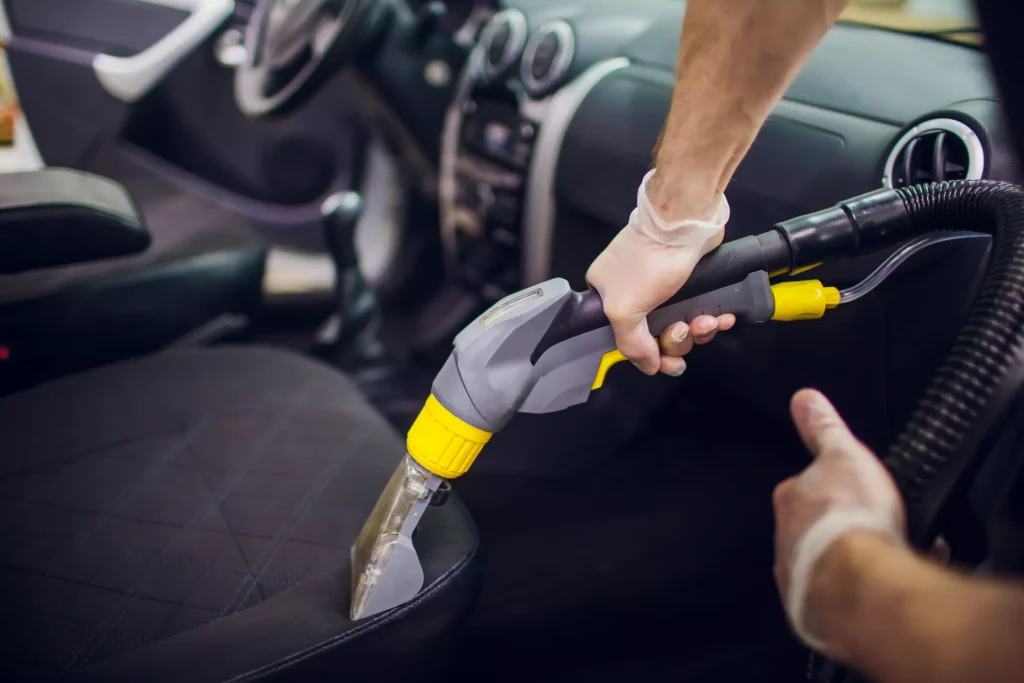
Machine-based deep cleaning using specialized upholstery attachments for thorough restoration
What you’ll need: Carpet cleaner machine, upholstery cleaning solution
- Vacuum seats thoroughly.
- Fill the carpet cleaner with upholstery cleaning solution and water as directed.
- Use the upholstery attachment to clean the seats.
- Work in small sections, overlapping slightly.
- Make a second pass with just water to rinse.
- Allow seats to dry completely.
Pro tip: Open windows or use fans to speed up drying and prevent mold.
12. Coffee Stain Removal
What you’ll need: Glass cleaner or lemon juice, water, a clean cloth
- Blot the stain with a damp cloth to remove excess coffee.
- Spray glass cleaner on the stain or apply lemon juice.
- Let it sit for 5 minutes.
- Blot with a clean, damp cloth.
- Repeat if necessary.
Alternative: Try a mixture of vinegar and water for stubborn coffee stains.
13. Lipstick Stain Removal
What you’ll need: Non-gel white toothpaste, soft cloth
- Apply a small amount of white toothpaste to the stain.
- Gently work it into the fabric with a soft cloth.
- Let it sit for 5 minutes.
- Wipe clean with a damp cloth.
- Repeat if necessary.
Caution: Always test on an inconspicuous area first to ensure it doesn’t damage the fabric.
14. Fabric Protector Application
What you’ll need: Fabric protector spray
- Clean and thoroughly dry the seats.
- Shake the fabric protector spray well.
- Hold the can 6-8 inches from the seat surface.
- Apply in a light, even coat.
- Allow to dry completely before use.
- Apply a second coat for maximum protection.
Pro tip: Reapply fabric protector every 6-12 months for continued protection.
15. Regular Maintenance
What you’ll need: Seat covers, regular cleaning supplies
- Install seat covers for added protection.
- Vacuum seats weekly.
- Wipe down seats with a damp microfiber cloth monthly.
- Address spills and stains immediately.
- Perform a deep clean every 3-6 months.
Pro tip: Keep a small cleaning kit in your truck for quick cleanups on the go.
Maintaining clean cloth seats in your Ford F150 doesn’t have to be daunting. With these 15 DIY methods, you can tackle everyday dirt and stubborn stains. Always test cleaning solutions on a small, inconspicuous area first, and never oversaturate your seats. Regular cleaning and maintenance will keep your F150’s interior looking great and extend the life of your cloth seats.




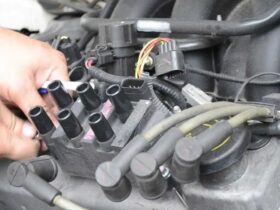
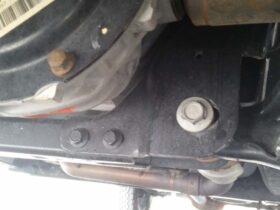
Leave a Reply
View Comments